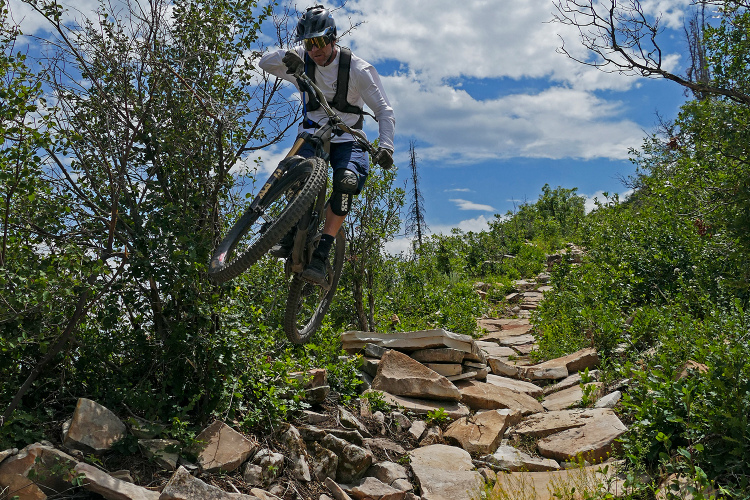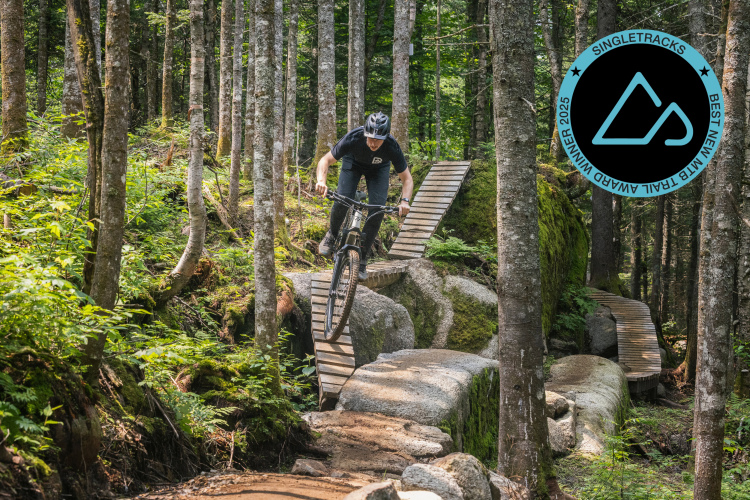
Neutrality is impossible — we’re all shaped by our prejudices and preferences. If you have a bad experience just once with a brand, it can spoil your view forever. Likewise, we all want to think the best of the stuff we love.
So I’ll be upfront — I’m a big Transition fan.
The clean, slack lines of their frames has always appealed to me. I like the fact they’re designed and ridden by people in muddy, wet places. And if any brand can be said to have a distinctive ride feel, Transition’s springy, BMX-ish handling makes my inner nine year old grin from ear to ear.
So I approached this review with excitement. The Transition Sentinel v3 is one of the brand’s longest travel single-crown bikes, and I got to ride it for several weeks before its release, in a bunch of different places. A five-hour descent of the Palisade Plunge. Jump trails in Durango. Brutal climbs up the Monarch Crest trail, steep rock rolls in the deserts of Las Vegas, and even a couple of trips to the store for dinner supplies. It’s been in and out of three different trucks, covered in a metric ton of dust, and it’s shared a couple of motel rooms with me. We’ve grown close. 😉
So this review is about as comprehensive as it’s going to get.
TL;DR version? It’s almost my ideal bike, but with a couple of caveats.
In this review
The Sentinel has been in the Transition lineup since 2018, and was their first long-travel 29” bike, back when that was far from being the industry standard. The fact that it’s still part of the range means enough people like this bike for them to keep making it for the past seven years.
But we all — brands and riders alike — have to be on the lookout for marketing dressed up as innovation. So I have two important questions: is this bike still relevant when every brand makes a long-travel 29er, and is it different enough from the last model to be worthy of attention?
Transition Sentinel v3 key specs
- 160/150mm suspension travel front/rear
- Price: $6,199 as tested
- Buy from Transition dealers

What’s changed
In terms of geometry and design fundamentals, not that much has changed — but I think that’s a good thing. Transition isn’t pretending to be all things to all people, and none of their bikes are designed to appeal to folks who like sitting down in the saddle, so I’m glad the geometry is still basically the same. A slack head tube angle, big standover, short chainstays — they’re all still in place.
The new Transition Sentinel has a flip-chip under the rear shock, specifically designed to allow for a mixed-wheel conversion. I didn’t try it, but if I owned one of these I’d be sorely tempted; it would make an already nimble and agile bike even sportier, and might shave seconds off enduro race runs. This isn’t a world-changing innovation — flip chips and multi-position geometry is widespread — but it’s got a specific, useful purpose that would actually make a big difference to the ride feel.


Redesigned shock mount
I spend half the year riding in the UK, and this issue is a big pet peeve — I hate Horst-link suspension designs that don’t think about dirt. Tiny, inaccessible channels underneath shock mounts that fill with mud or water in seconds and are impossible to clean drive me nuts. So the fact that Transition has thought about that from the rider’s perspective is welcome, if a little late. There’s no depression in the Sentinel frame under the mount, so dirt and water won’t pool, and there’s just enough space to push a small brush or a rag in there to clean it out. It’s still awkward, but it’s better than any other design I’ve seen.

Frame storage
You could argue that frame storage is a little overdue on the Transition Sentinel, but it’s thoughtfully done. The big lever on top of the storage box is great — it’s easy to open and close, even while riding — and the storage compartment is capacious. I’ve been tempted to store a whole fresh baguette in there, just for fun. The internal cabling is clipped to the inside of the frame to maximise space, and the cables are properly housed so you can’t damage or dislodge them with a stray multi-tool or whatever.
On the trail
First and biggest thing – this bike climbs just fine, even great for the slackness of the geo, but it’s definitely a locked-out shock situation. I’ve ridden plenty of enduro-sized 29” bikes that are set and forget for both climbing and descending, but this isn’t one of them. With the rear shock locked out, the Sentinel climbs in a satisfyingly agile way. Shifting position, unweighting for hops and hucks, taking last-minute line decisions — all that feels easy and intuitive. The slack head tube angle makes the front end super-easy to pop up, and the loss of travel from the locked-out shock actually helps on technical rocky terrain, as it keeps your weight and momentum right where it should be.

There are lighter-feeling, smoother-climbing bikes in this category — the Rocky Mountain Altitude and Pivot Switchblade spring to mind — but I attacked a bunch of different technical climbs on the Transition Sentinel and really enjoyed the feel. I never had to fight it, or work harder than I wanted to wrestle it around, and there’s an eagerness to the power transfer from leg to bike that makes things feel pacy rather than plodding.
Share your Transition Sentinel review
The short chainstays, high standover and 800mm-wide bars are obviously designed to promote irresponsibly fast descents, but a bike like this needs to feel comfortable on traverses and longer sections of pedalling too. Ultimately, I never felt even a twinge of discomfort on flat, pedally traill sections. The size large carbon build I tested has a reach of 480mm, which is slightly shorter than my personal bike, but the expected increase in lower back discomfort never came. And here again, the instant power transmission made big flat efforts feel natural.

Get onboard with the get-down
Just like real life, it’s the downhill section that comes last, and you won’t be surprised to learn that it’s where the Sentinel truly comes into its own. That springy, sporty feel — the one that makes my inner BMX kid get all twitchy and short of breath — is what makes all Transition bikes I’ve ever ridden feel unique, and this one is no exception. There’s a burliness to it thanks to the 150mm or travel, and a greater feeling of security over the front wheel in fast berms, but it’s still a pretty giddy goat of a mountain bike. I think I hit every possible rock, root, kicker and curb, on more than ten separate rides, and enjoyed every inch of air I could grab, even the dumb ones at 3mph in the parking lot. This bike wants to play.
On fast, flowing singletrack through the aspens along Monarch Crest, I could throw the frame from side to side at will, and push onto the side of the Maxxis Assagai/ DHR II tire combo with a satisfying certainly, then fly over lumpy shale the very next second without being shaken to death. That playfulness wasn’t skittish either — steep crawls down slabs and rock gardens felt planted, and I was able to get serious weight over the front wheel without losing stability or washing out.
Fly boy
I’m not the world’s most ambitious jumper — more than a couple of bike lengths and I start coughing and mumbling — but I hit a massive variety of natural kickers, some bigger built tabletops and gaps, and as much of a drop as I’m capable of, and any mistakes were my fault, not the Sentinel’s. The RockShox Lyrik fork soaks up the hits really well, even with my preferred bouncy setup, and I felt I could have added more air to the rear without compromising grip or impact absorption.

Pros and cons of the Transition Sentinel v3
Pros
- Super-nimble ride feel for such a large bike
- Improved shock mount
- Flip-chip allows for mixed wheel setup
Cons
- Needs to be locked out to climb well
- Might take some work to get the correct sizing
- Seat clamp bolt could be recessed for weather protection
Bottom line
There’s how it’s built, and how it works, and that’s all important, but the key question is: How does the Transition Sentinel v3 feel to ride?
I loved it. I’m never going to threaten the podium at an enduro race, or go viral for the size of my jumps and drops, or get anything other than a polite nod of acceptance on the bike park — but the Sentinel made me feel as if I could, and ride as if I should. This bike wants you to get involved, to notice every possible line on the trail, to pop off every possible kicker, and to dance your way down technical rocks like Sam Rockwell on a talk show. Not for results, or glory, but for your own inner shredder. It speaks directly to that part of your brain that’s always wanting to corner a little faster, jump a little further, and descend something a little steeper, no matter what kind of rider you are.
If you bought one of these and you weren’t a better, happier rider within a year, it would not be the Sentinel’s fault.
Edit 10/28/24: The Sentinel is one of Transition’s longest, single-crown bikes, not the longest. The brand’s longest-travel single-crown bike is the Spire, followed by the Patrol.











2 Comments
Oct 23, 2024
Oct 24, 2024